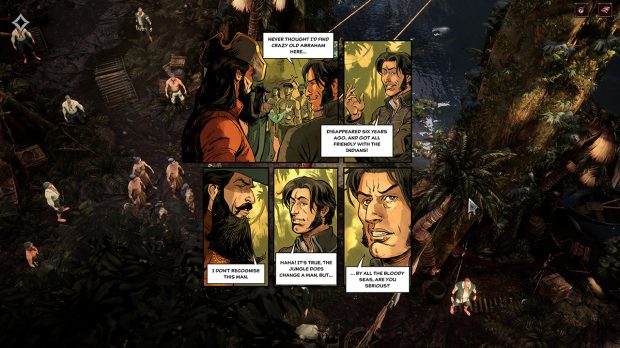Flint: Treasure of Oblivion sets sail with a captivating premise: a pirate adventure in a world inspired by historical accuracy and brought to life with a unique comic book aesthetic. While it delivers on its promise of swashbuckling fun and strategic combat, some choppy waters prevent it from reaching the treasure island of truly great games.
The game casts you as Captain James Flint, tasked with uncovering a legendary treasure using a mysterious map. Along the way, you’ll recruit a motley crew, each with unique skills and personalities, and engage in turn-based tactical battles against rival pirates and other foes. The combat system is where Flint truly shines. It blends strategic positioning with a card-based system that adds an element of both planning and chance. Each character can equip cards that grant special abilities or enhance their attacks, and these cards are further influenced by dice rolls, leading to dynamic and often unpredictable battles. Learning to utilize different card combinations and adapt to the whims of fate is crucial for success, and mastering the system is deeply satisfying.
Beyond the strategic depth of combat, Flint also boasts a visually striking presentation. The comic book art style is beautifully implemented, with character portraits and cutscenes rendered in vibrant colors and dynamic panels. This stylistic choice adds a unique flavor to the game and effectively captures the adventurous spirit of the pirate world. The environments, powered by Unreal Engine 5, are equally impressive, ranging from bustling port towns to treacherous jungles and hidden caves.
However, while Flint has a lot to offer, it’s not without its shortcomings. The user interface, while functional, can feel clunky and unintuitive at times, making it difficult to navigate menus and manage your crew effectively. Furthermore, several reviewers have pointed out issues with the game’s controls and level design, citing unclear pathways and a lack of visual cues. These issues, while not game-breaking, can lead to moments of frustration and detract from the overall experience.
Another common criticism is the game’s relatively short length. While the core gameplay loop is engaging, the adventure feels somewhat condensed, leaving players wanting more. This brevity might disappoint those seeking a sprawling RPG experience, but it could also be seen as a positive for players who prefer more focused and concise narratives.
Ultimately, Flint: Treasure of Oblivion is a mixed bag. Its innovative combat system, striking visuals, and unique setting make it a compelling experience for fans of tactical RPGs and pirate lore. However, its technical shortcomings, including a clunky UI and occasionally frustrating level design, hold it back from reaching its full potential. If you’re willing to overlook these flaws and embrace the game’s unique charm, you’ll find a rewarding adventure filled with strategic battles and swashbuckling fun.







